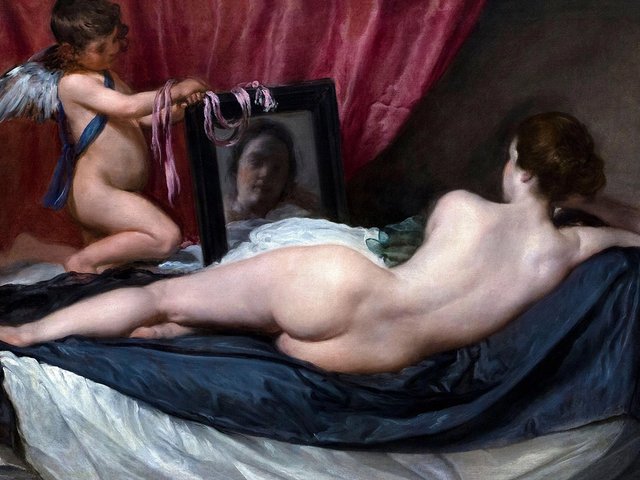“I got five lovely shots in,” the suffragette Mary Richardson, also known as “Slasher Mary”, proudly recalled in an interview with the BBC in 1961. She was referring to the fateful day in March 1914 when, after milling around London’s National Gallery for hours, she removed a meat cleaver pinned inside her sleeve and set upon Velázquez’s The Toilet of Venus (Rokeby Venus), 1647-51. She remembers feeling lucky to get in a few more blows as the warder mistakenly attributed the sound of breaking glass to a broken skylight. He eventually seized Richardson as she was still “hammering away” at the picture. But the damage was done: the long slashes that dotted the reclining nude’s back resembled gaping wounds in her flesh. Richardson’s assault was not without purpose, however: it was a protest against the imprisonment of fellow suffragette Emmeline Pankhurst. “I have tried to destroy the picture of the most beautiful woman in mythological history as a protest against the government for destroying Mrs Pankhurst, who is the most beautiful character in modern history,” Richardson told police after the attack.
The Rokeby Venus is just one in a long list of works targeted by suffragettes between 1913 and 1914 as part of a militant campaign to win women the right to vote. The Manchester Art Gallery bore the brunt of these attacks in 1913, when 13 paintings, including Burne-Jones’s Sibylla Delphica, around 1886, were damaged in a brazen attack. Two months after Richardson slashed the Velázquez, five more works in the National Gallery were attacked: this time, the artist was the Italian painter Gentile Bellini, and the weapon of choice a cane.
The suffragettes’ campaign is examined in Tate Britain’s exhibition “Art under Attack: Histories of British Iconoclasm”, which explores various strategies behind the deliberate destruction of art in Britain from the 16th century to the present day. Sadly, the Rokeby Venus, which Richardson continued to visit years after the attack to “cheer [herself] up”, is not included. A spokeswomen from the Tate and National Gallery refused to say whether the Tate had asked to borrow the work, but it would be surprising if it had not requested its loan. A spokeswoman from the National Gallery did say, however, that “Velázquez’s painting is one of the most famous works in the [museum] and is rarely lent”.
In its place are a 1914 photograph of the painting showing Richardson’s handiwork, her official police photograph and an audio recording of her BBC interview. Pieces such as John Singer Sargent’s 1913 Portrait of Henry James, expertly restored following an attack at the hands of an older woman “of distinctly peaceable appearance” at London’s Royal Academy in 1914, and an open letter to the suffragettes from Wyndham Lewis, asking them to “stick to what you understand” and “leave works of art alone”, round out the section on the suffragettes.
The exhibition opens with a room on Henry VIII’s dissolution of the monasteries (1536-40). Sculptures were smashed and memorials plundered not only because of their subject matter but also so that their valuable metal could be extracted and sold. Furnishings and manuscripts were burned to fuel the fires needed to smelt the lead into ingots that could be easily hauled away. The room is filled with shards of glass, book clasps, manuscripts with offending images cut out, brass letters from memorials and sculptures, including fragments from Thomas Becket’s shrine (demolished in 1538) in Canterbury Cathedral.
A 13th-century stone statue of Christ in Majesty from North Yorkshire’s Rievaulx Abbey is missing its head and hands: the hands are likely to have been lost when attackers wrenched out the metal attributes they once held, says the show’s co-curator Tabitha Barber. Thomas Jackson’s painting Canterbury Cathedral Choir, 1657, which is on loan from a private collection, shows iconoclasm in action a century after the dissolution, with men smashing sculptures and stained-glass windows.
The star of the show is the hyperrealistic Statue of the Dead Christ, around 1500-20, which has never before been on loan to an exhibition. It was discovered buried beneath the floor of the chapel in Mercers’ Hall, London, in 1954. There was no record of the sculpture before it was excavated, and experts consider it one of the most important extant examples of pre-Reformation religious sculpture made in England. Its survival is remarkable, considering that around 90% of religious works of this kind from the period were lost. The figure shows telltale signs of a deliberate attack: Christ’s right arm and part of his left are missing, as are his feet, which would have held the marks of his crucifixion.
The earlier rooms are the most successful; the theme becomes more and more tenuous as the exhibition progresses towards the 21st century, especially in the final room, which features “art transformed” by the likes of the Chapman brothers and Douglas Gordon (which is hardly iconoclasm). But the opportunity to see rare surviving works of the Reformation make it worth the trip. “The show is a gathering of some really unique survivals from this period in British history,” Barber says.
• Originally appeared in The Art Newspaper with the headline "Art and the appetite for destruction"


